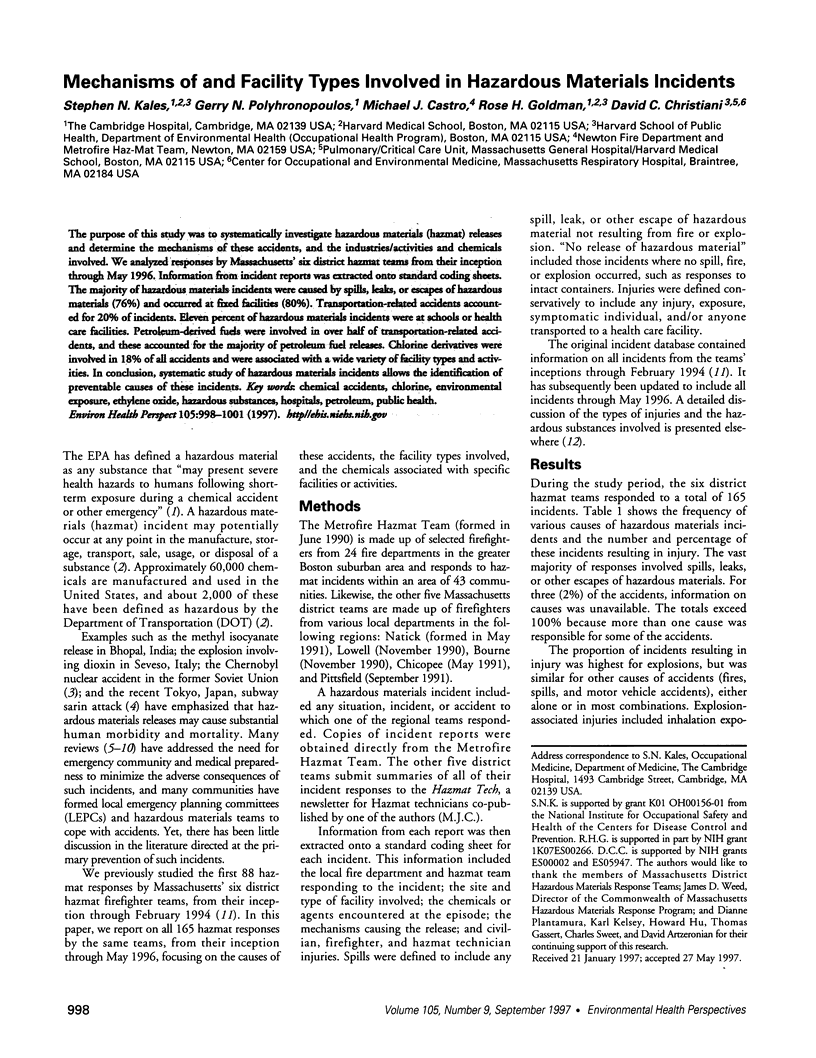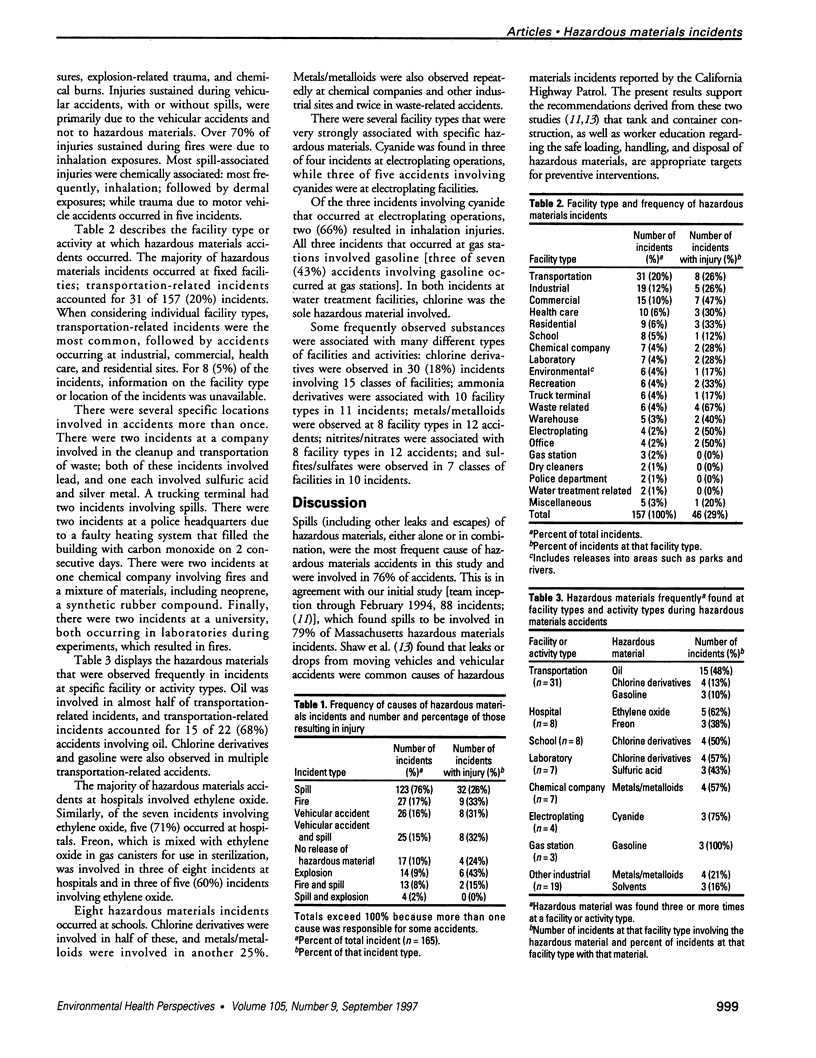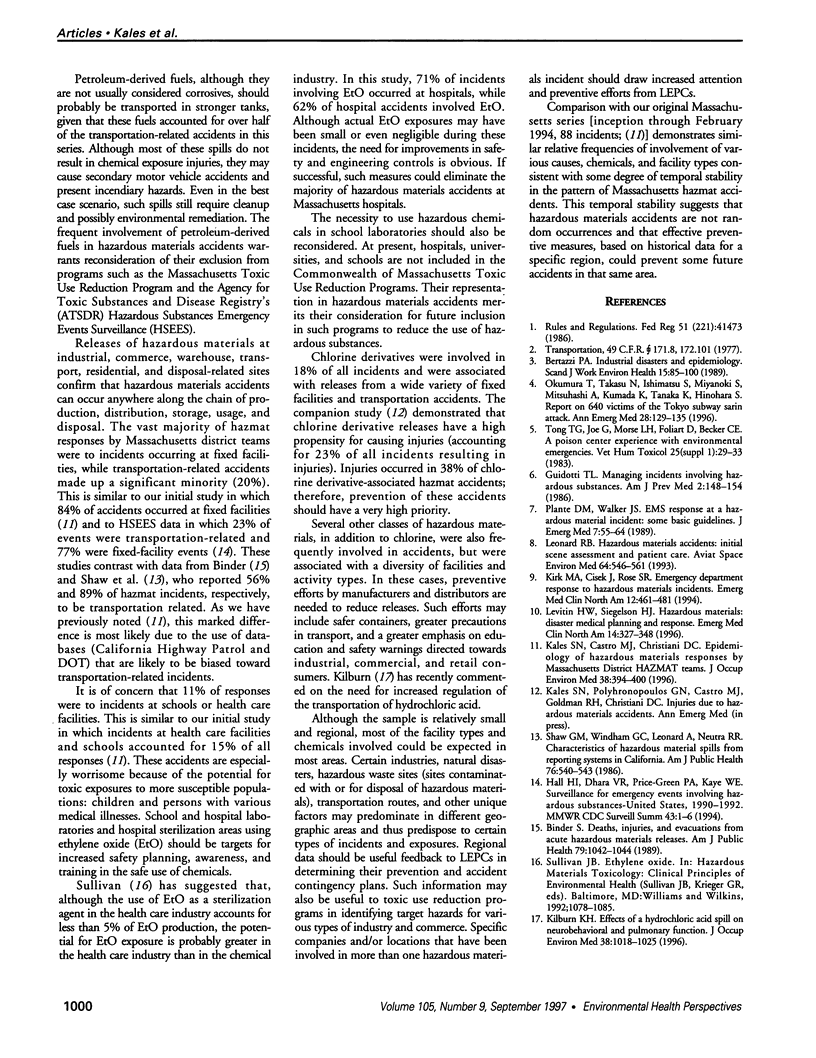Abstract
The purpose of this study was to systematically investigate hazardous materials (hazmat) releases and determine the mechanisms of these accidents, and the industries/activities and chemicals involved. We analyzed responses by Massachusetts' six district hazmat teams from their inception through May 1996. Information from incident reports was extracted onto standard coding sheets. The majority of hazardous materials incidents were caused by spills, leaks, or escapes of hazardous materials (76%) and occurred at fixed facilities (80%). Transportation-related accidents accounted for 20% of incidents. Eleven percent of hazardous materials incidents were at schools or health care facilities. Petroleum-derived fuels were involved in over half of transportation-related accidents, and these accounted for the majority of petroleum fuel releases. Chlorine derivatives were involved in 18% of all accidents and were associated with a wide variety of facility types and activities. In conclusion, systematic study of hazardous materials incidents allows the identification of preventable causes of these incidents.
Full text
PDF


Selected References
These references are in PubMed. This may not be the complete list of references from this article.
- Bertazzi P. A. Industrial disasters and epidemiology. A review of recent experiences. Scand J Work Environ Health. 1989 Apr;15(2):85–100. doi: 10.5271/sjweh.1867. [DOI] [PubMed] [Google Scholar]
- Binder S. Deaths, injuries, and evacuations from acute hazardous materials releases. Am J Public Health. 1989 Aug;79(8):1042–1044. doi: 10.2105/ajph.79.8.1042. [DOI] [PMC free article] [PubMed] [Google Scholar]
- Guidotti T. L. Managing incidents involving hazardous substances. Am J Prev Med. 1986 May-Jun;2(3):148–154. [PubMed] [Google Scholar]
- Hall H. I., Dhara V. R., Price-Green P. A., Kaye W. E. Surveillance for emergency events involving hazardous substances--United States, 1990-1992. MMWR CDC Surveill Summ. 1994 Jul 22;43(2):1–6. [PubMed] [Google Scholar]
- Kales S. N., Castro M. J., Christiani D. C. Epidemiology of hazardous materials responses by Massachusetts district HAZMAT teams. J Occup Environ Med. 1996 Apr;38(4):394–400. doi: 10.1097/00043764-199604000-00018. [DOI] [PubMed] [Google Scholar]
- Kilburn K. H. Effects of a hydrochloric acid spill on neurobehavioral and pulmonary function. J Occup Environ Med. 1996 Oct;38(10):1018–1025. doi: 10.1097/00043764-199610000-00012. [DOI] [PubMed] [Google Scholar]
- Kirk M. A., Cisek J., Rose S. R. Emergency department response to hazardous materials incidents. Emerg Med Clin North Am. 1994 May;12(2):461–481. [PubMed] [Google Scholar]
- Leonard R. B. Hazardous materials accidents: initial scene assessment and patient care. Aviat Space Environ Med. 1993 Jun;64(6):546–551. [PubMed] [Google Scholar]
- Levitin H. W., Siegelson H. J. Hazardous materials. Disaster medical planning and response. Emerg Med Clin North Am. 1996 May;14(2):327–348. doi: 10.1016/s0733-8627(05)70254-6. [DOI] [PubMed] [Google Scholar]
- Okumura T., Takasu N., Ishimatsu S., Miyanoki S., Mitsuhashi A., Kumada K., Tanaka K., Hinohara S. Report on 640 victims of the Tokyo subway sarin attack. Ann Emerg Med. 1996 Aug;28(2):129–135. doi: 10.1016/s0196-0644(96)70052-5. [DOI] [PubMed] [Google Scholar]
- Plante D. M., Walker J. S. EMS response at a hazardous material incident: some basic guidelines. J Emerg Med. 1989 Jan-Feb;7(1):55–64. doi: 10.1016/0736-4679(89)90411-3. [DOI] [PubMed] [Google Scholar]
- Shaw G. M., Windham G. C., Leonard A., Neutra R. R. Characteristics of hazardous material spills from reporting systems in California. Am J Public Health. 1986 May;76(5):540–543. doi: 10.2105/ajph.76.5.540. [DOI] [PMC free article] [PubMed] [Google Scholar]
- Stancel G. M., Boettger-Tong H. L., Chiappetta C., Hyder S. M., Kirkland J. L., Murthy L., Loose-Mitchell D. S. Toxicity of endogenous and environmental estrogens: what is the role of elemental interactions? Environ Health Perspect. 1995 Oct;103 (Suppl 7):29–33. doi: 10.1289/ehp.95103s729. [DOI] [PMC free article] [PubMed] [Google Scholar]


